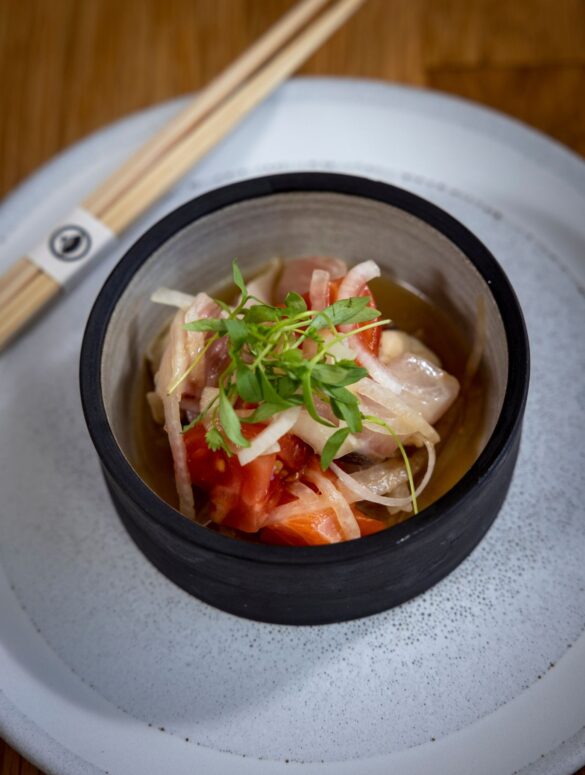Text by Victor Ramsey
Images by Nancy Pastor
I scrutinized the product—a sliver of fish atop an oblong ball of rice—with the intensity and focus of an F1 driver at the starting line. Chef Moriyuki, placing the nigiri sushi on the earthenware dish before me, gave the fish its name: “baby snapper”—or kasugodai in Japanese. Its pearlescent skin, left on, was flecked with green from a dusting of zested yuzu. Its unblemished flesh, which ran in gradient from warm translucence to sunset-pink, testified to the keen knife work that had separated it from the filet in a single unwavering stroke.
I watched, admiringly, as the ball of rice, touching down on the ceramic plate, settled ever-so-slightly into itself, easing gently downward under its own weight, as if releasing a gentle sigh. This almost imperceptible movement was a promising sign, indicating that the latticework of rice had not been overly compressed in the hands of the chef (which would mark a critical lapse), and so retained an airiness between the grains that would lead to a pleasing dispersal upon their happy arrival to my mouth.
For moments like this—poignant, expectant—I had (yet again) reshuffled my monthly budget, borrowing from the already anemic gas and grocery line items to reallocate to the overtopped sushi category, offering myself the token reassurance that a budget represented an ideal to aspire to, not an ironclad diktat to be slavishly obeyed. And anyways, to not let things get out of hand, I pledged to abstain from sake with the meal and to stoically forego any extra orders at its conclusion. All this bargaining and equivocation, just to get my lunch time fix at the newest entrant to Santa Monica’s high end sushi scene: Brothers Sushi, a Woodland Hills institution that had recently planted its second flag on the other side of the mountain, among the posh and breezy shops and eateries of Montana Avenue.


An hour later, as I waited for my add-on orders of dashi-marinated salmon eggs (magical orbs that burst rich salinity), giant clam (with its oceanic crunchiness), and pen-shell scallop (a sweeter, denser version of its more common cousin) to arrive, and as the waiter offered up a generous pour of my third sake—this one a honjozo fittingly named “Endless Summer”—I wondered vaguely how I had found myself, yet again, blowing budgets and breaking pledges for the sake of raw fish on rice.
My obsessive descent into edomae (Tokyo-style) sushi began with a trip to Japan in my early thirties. There, a fateful bite of raw sardine—of all things—draped over a pillow of vinegared rice provided me my first experience of sushi-induced bliss. I returned to Los Angeles desperate to find a local joint that could replicate that high. I set money aside—dedicated to sushi, and sushi alone—and ventured from Pasadena to Simi Valley, Torrance to the San Gabriel Valley, following leads gathered from food forums, Instagram accounts and magazines, in search of that perfect bite, that next fix.
The search has lead me to every corner of Los Angeles and beyond. I’ve gone over budget several times. It may be time to admit I have a problem.
That’s what’s brought me here to one of my favorites, Brothers Sushi, enjoying a late afternoon meal while trying my best to not consider its financial consequences. I found some degree of solace for my shortcomings in commiserating with the woman sitting next to me at the counter who, after her previous visit, had resolved to wait a respectable month before returning for her next meal. Yet here she was, three weeks later (so close!), biting contentedly into orange lobes of Hokkaido uni that had been enfolded, taco-like, into a strip of crispy nori that crackled audibly as it shattered while she chewed. Her ensuing groan of satisfaction seemed to indicate she had forgiven herself.

Pleasant satiety, intermingling with the warmth of the sake, fostered in me a general sense of wellbeing. I wondered how such a seemingly simple food as nigiri sushi, consisting of no more than a topping (neta in Japanese, usually fish) on seasoned sushi rice (shari), had come to captivate appetites of so many Angelenosand. Specifically, the format of this cuisine known as omakase—wherein the customer leaves it to the chef to decide the substance and sequence of the meal (translated from the Japanese, it means “to entrust” or, more loosely, “I will leave it up to you”)—seems to have worked its magic on not only my palate, but the collective. What special power resided in this style of cuisine that its appeal drove scores of foodie pilgrims to seek it out across Los Angeles, eager to pay expensive tribute at these temples of rice and fish?
The aughts had seen a remarkable profusion of omakase-focused sushi-yas weave themselves into the fabric of the city, like so many jewels fashioned upon a royal robe. With minimal seats (often counter only) and maximal prices (the going rate at the ultra-high end establishments can now run well over $250 for food alone), they had found their place in the most unassuming of locations; buried in the basement of office buildings (like Sushi Kaneyoshi in DTLA), or behind boarded-up exteriors (see Mori Sushi in West LA), or, most commonly, tucked into discrete corners of generic strip malls (Matsumoto in West Hollywood, Kogane in Alhambra, Takeda in Little Tokyo).
As quickly as they multiplied, so too did their customers, whose insatiability was matched only by their seemingly unlimited funds. As the late great sage of the Los Angeles food scene Jonathan Gold rightly noted, Angelenos had proven themselves far more willing to expend their fine dining budgets on processions of raw fish at humble sushi-yas than on more buttoned-up and extravagant prix-fixe, multi-course meals at a New American or French-inflected restaurants. But why?
Answers to these questions were forestalled by the arrival of my check upon the birch wood bar. At $200 dollars for lunch—$90 for the omakase, plus $30 for the inadvertent add-ons, the rest on drinks and tax—the meal, truth be told, proved a relative bargain considering its superb quality and reasonable portions. And with multiple bottles of sake on the menu clocking in at over $700, not to mention a bottle of Napa red for $1400, I knew things could have been much, much worse.
As I settled up, the genial waiter, perhaps noticing a certain solemnity befall me, provided a complimentary pour of plum wine. Fuchsia-toned and velvet-textured, the wine’s happy interplay of sweet and sour succeeded in buoying my spirits.

I realized then that perhaps the mystery of omakase’s ascendance was not so mysterious after all. In a world that scatters our attentions across a thousand and one distractions, here is a cuisine that, through its deliberate pacing and gradual progression, through its austere technique and limited ingredients, works to quiet the mind and channel its focus. I watch, rapt, as the mackerel is sliced, the rice sculpted, the wasabi dabbed, the neta pressed and molded into the shari, until the nigiri achieves its final, quintessential form. I admire the chef’s economy of movement, poised and purposeful and devoid of undue expenditure, honed through countless repetitions.
I remind myself of the long chain of hidden labors that made this perfect bite possible—the fishermen in Boston, Hokkaido, and the Canary Islands who stake their livelihoods on the fickle sea; the distributors and fish mongers who assess, sort and send the choicest specimens to their most deserving customers, with whom they have built reciprocal trust over many years. I think of the chef’s early rise each morning, day after day, to break down the fish, debone it, age, cure, and marinate it, to prepare the rice to the most exacting of specifications. I marvel at the years of training required to learn to do this properly. We, the omakase obsessives, behold these diverse efforts concentrated into the edible object before us, rice and fish, a study in simplicity borne of monumental efforts.
Perhaps seeking out this style of eating is not so much an addiction as a brief reprieve from them, from the phone’s insistent notifications, a job’s incessant demands, from the regrets of the past and concerns for the future. Here was a space devoted to fashioning perfect simplicity from untold complexity, and that asks nothing but to pay attention, to appreciate, and, of course, to pay up.
Three other high-end sushi omakase restaurants worth blowing your budget for…
11500 W. Pico Blvd.
West LA
Chef Maru puts on a one man show at this West Los Angeles stalwart. Hosting only a few small groups of private diners an evening, Mori Sushi maintains its focus on serving the most understatedly exceptional edomae cuisine in the city. $250 – $300. morisushila.com
Shunji
3003 Ocean Park Blvd
Santa Monica
Firmly established in its new counter-only Santa Monica digs, eponymous chef Shunji Nakao continues his Michelen-starred tradition of creatively-composed small plates and red-vinegared nigiri, crafting perfect bites for the discerning diner. $250. shunji-ns.com
8385 Beverly Blvd
Beverly Grove
Offering an unmatched variety of fish from a discrete West Hollywood strip mall, Matsumoto pairs neighborhood comfort with broad ambition, plating some of the finest sushi to be found on the Westside. $130 – $250 matsumoto-restaurant.com


